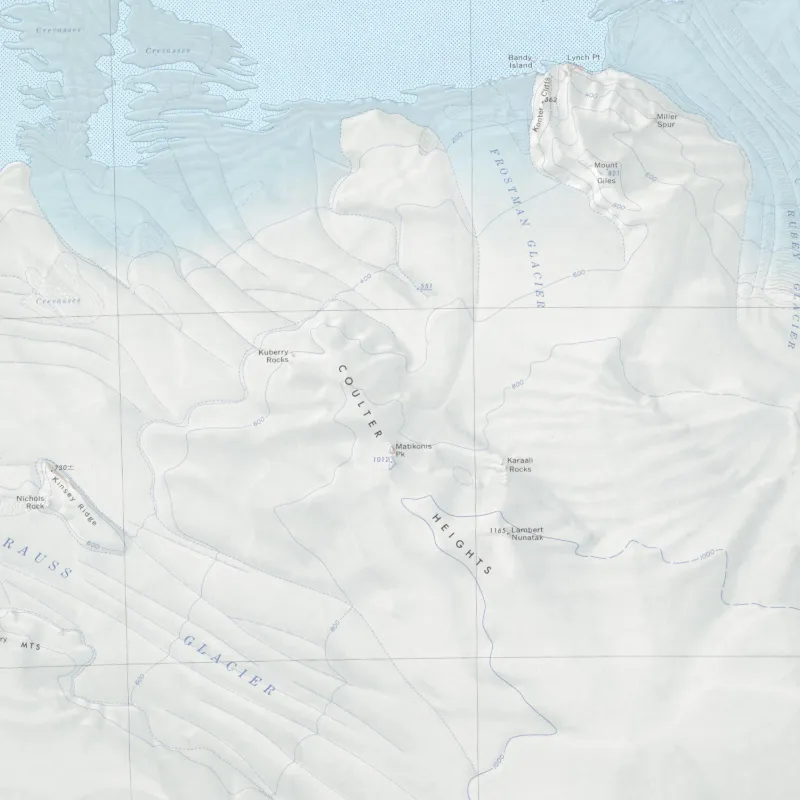Krigsvold Nunataks
Nestled in the heart of Marie Byrd Land, the Krigsvold Nunataks stand as silent sentinels at the head of Strauss Glacier. These isolated peaks, part of the majestic and enigmatic landscape of Antarctica, are not just geographical features but markers of human endeavor and the spirit of exploration that defines our interaction with the world’s most remote continent.
Origin and Naming
The Krigsvold Nunataks were named in honor of Sgt. Alvin I. Krigsvold, a distinguished member of the United States Army. Sgt. Krigsvold was a crucial part of the Army-Navy Trail Party in 1956, which blazed a trail from Little America V to establish Byrd Station. His work exemplifies the courage and innovation required to venture into the uncharted expanses of Antarctica.
This act of bravery and exploration is immortalized in the naming of these nunataks, as recognized by the United States Gazetteer and the SCAR Composite Gazetteer of Antarctica. The name serves as a reflection to the human drive to chart the unknown and contribute to the collective understanding of our planet.

Geographic Location
- Latitude: 75° 38’ 00.0’’ S (-75.63333°)
- Longitude: 137° 55’ 00.0’’ W (-137.91667°)
Situated directly at the head of Strauss Glacier, the Krigsvold Nunataks’ precise location underscores their significance in the vast expanse of Marie Byrd Land. Though their altitude is not recorded, their presence serves as a notable landmark for scientific research and exploration in one of the least accessible regions of the world.
Historical Significance
Mapped by the United States Geological Survey (USGS) from surveys and U.S. Navy air photos between 1959-65, the Krigsvold Nunataks symbolize the interplay between human exploration and the harsh realities of the Antarctic environment. Their naming after Sgt. Alvin I. Krigsvold reflects the intertwined nature of geographical discovery and the personal stories that accompany these endeavors.
The nunataks serve as enduring reminders of the challenges overcome in exploring Antarctica, contributing to our understanding of its geography, climate, and global significance.
Contribution to Antarctic Research
The Krigsvold Nunataks offer unique opportunities for scientific study:
- Glaciology: These nunataks provide key insights into the dynamics of the Strauss Glacier and the processes shaping ice flow in the region.
- Geology: Their exposed rock formations offer a window into the geological history of Antarctica, aiding researchers in reconstructing past climates and earth processes.
- Climate Science: As part of the unspoiled wilderness of Marie Byrd Land, these peaks play a crucial role in global climate studies by serving as indicators of environmental change.
Matikonis Peak
Matikonis Peak, a prominent landmark within the central Coulter Heights, pierces the snow mantle of Marie Byrd Land, near Antarctica’s coast. This small yet striking rock peak stands as a testament to the enduring presence of nature amidst the ice and snow of one of the world’s most remote regions.
Origin and Naming
Named in honor of William P. Matikonis, a dedicated Damage Controlman aboard the USS Glacier during the 1961-62 Antarctic expedition, Matikonis Peak embodies the spirit of exploration and commitment that characterizes human engagement with Antarctica.
This naming, recognized by the United States Gazetteer and the SCAR Composite Gazetteer of Antarctica, highlights the vital role of support and operational staff in facilitating Antarctic research and exploration. Matikonis’s contributions demonstrate that behind every scientific discovery lies a team of individuals committed to making such progress possible.

Geographic Location
- Latitude: 75° 21’ 00.0’’ S (-75.35000°)
- Longitude: 138° 14’ 00.0’’ W (-138.23333°)
The peak’s position in the central Coulter Heights, near the Antarctic coast, underscores its geographical significance as a navigational landmark and a focal point for scientific study within the vast expanse of Marie Byrd Land.
Historical Significance
Mapped by the United States Geological Survey (USGS) from surveys and U.S. Navy air photos between 1959-65, Matikonis Peak stands as a symbol of the meticulous effort involved in charting Antarctica’s rugged terrain. The peak’s naming after William P. Matikonis celebrates the often-unsung heroes of Antarctic exploration, whose work ensures the safety and success of scientific endeavors.
Contribution to Antarctic Research
Matikonis Peak provides unique insights into Antarctica’s geological and climatic history:
- Geological Studies: The exposed rock of Matikonis Peak offers valuable data on the tectonic and volcanic processes that have shaped Marie Byrd Land over eons.
- Glacial Interactions: Its prominence through the ice mantle highlights the interplay between rock formations and ice flow, which is critical for understanding glacier dynamics.
- Climate Monitoring: As an isolated landmark, Matikonis Peak aids in long-term climate monitoring efforts, serving as a reference point for measuring changes in snow and ice cover.
Conclusion
Both the Krigsvold Nunataks and Matikonis Peak stand as enduring symbols of the spirit of exploration, the contributions of dedicated individuals, and the interconnectedness of humanity’s efforts to understand Antarctica. These remote landmarks not only illuminate the mysteries of the icy continent but also remind us of the resilience and ingenuity required to study and protect this critical part of our planet.